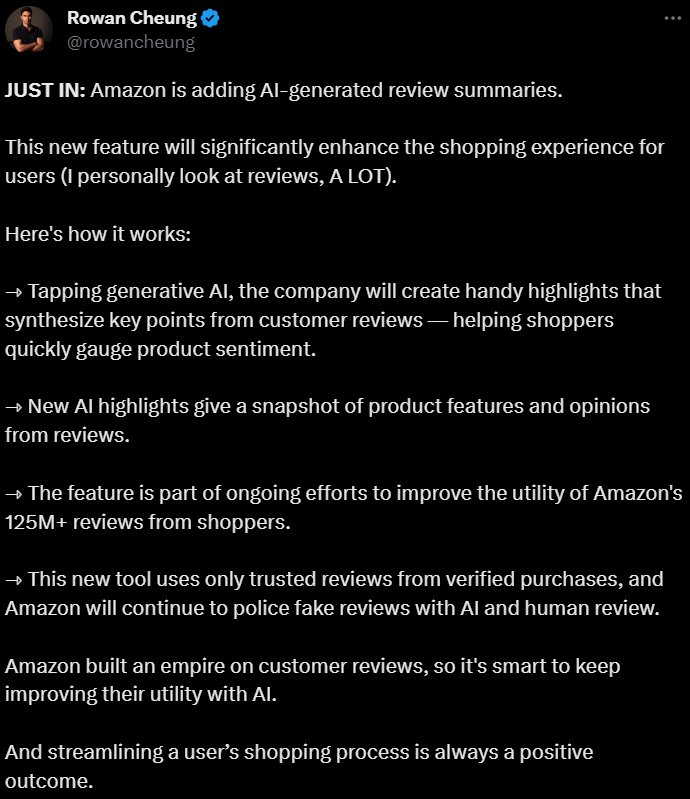
Amazon elevates c-commerce: Embracing next-gen generative AI applications. (Source – Shutterstock)
Is Amazon playing catch-up with its generative AI solutions?
|
Getting your Trinity Audio player ready... |
- Amazon launches generative AI tools and the AWS Innovation Center, aiming to rival Microsoft and Google in AI advancements.
- Amazon introduces Titan, Bedrock, and AI-summarized reviews to strengthen its stance in the generative AI landscape.
In the realm of generative AI and its various applications, several players have moved swiftly and invested heavily to capitalize on its growth. When OpenAI introduced ChatGPT in November, Microsoft garnered significant attention for hosting this viral chatbot and investing a reported US$13 billion in OpenAI. By February, Microsoft had integrated these generative AI models into its products, notably Bing. Concurrently, Google introduced its large language model, Bard, and invested a hefty US$300 million in Anthropic, a direct competitor in the field of generative AI applications.
Only in April did Amazon unveil its suite of large language models named Titan. This was complemented by a service dubbed Bedrock, aimed at aiding developers in leveraging generative AI. Historically, Amazon has pioneered market trends rather than followed them. This time, however, Amazon seems to be playing catch-up.
Amazon’s initiatives in generative AI
So, what’s Amazon’s strategy? The company recently launched the AWS Generative AI Innovation Center, a fresh initiative designed to guide customers in crafting and deploying generative AI solutions. With a US$100 million investment, this program aims to connect AWS AI and machine learning specialists with a global clientele to ideate, design, and roll out new generative AI offerings.
The Generative AI Innovation Center team will offer insights on responsible generative AI applications and efficient machine learning strategies. Engagements will provide strategic direction, tools, and support, facilitating clients’ use of AWS’s generative AI services. These include Amazon CodeWhisperer, an AI-driven coding assistant, and Amazon Bedrock, a comprehensive service offering access to foundational models from AI21 Labs, Anthropic, Stability AI, and Amazon’s Titan, via an API.
Building on these developments, Amazon is introducing a generative AI tool that encapsulates user product reviews. Piloted earlier this year, this tool offers buyers a snapshot of peer feedback without the need to sift through each review. It identifies prevalent sentiments and consolidates them into a concise paragraph on the product page.
A recent company blog post disclosed that these AI-synthesized reviews are available to a select group of U.S. mobile users across a broad product range. Based on user feedback, Vaughn Schermerhorn, Amazon’s Director of Community Shopping, has hinted at potential expansion plans.
Amazon’s expanding role in generative AI applications
In 2023, online reviews are pivotal for e-commerce businesses. The contemporary consumer is discerning, with most routinely researching products pre-purchase, often turning to online reviews. A staggering 89% of shoppers prioritize reading online reviews before making a purchase. Reviews have become an integral part of the shopping experience, holding significant influence. This is evident as 49% of global consumers rank positive reviews among their top purchase influencers.
Amazon has been actively exploring avenues to integrate more AI into its portfolio as the generative AI race intensifies. While the company hasn’t unveiled a standout AI chatbot or imaging tool, its focus is empowering developers to craft unique generative AI tools via AWS.
Amazon’s CEO, Andy Jassy, emphasized in a shareholder letter the significant potential of generative AI for the company. In a recent investor call, he further noted that every Amazon business segment deeply engages in multiple generative AI projects. This includes their devices division, which is responsible for products like Alexa.
Amazon streamlined feedback mechanisms to foster user engagement by actively soliciting user reviews within their app. The company also integrated cross-border review visibility, ensuring global users access to insights on identical products.
For apparel shopping, for instance, Amazon introduced a feature allowing users to filter reviews, showcasing feedback from individuals of comparable height and weight, thus aiding in fit assessment.
Beyond the AI-curated reviews, Amazon plans to introduce a “Product Insights” feature, spotlighting recurring themes in reviews. This AI tool will briefly summarize product pages, accentuating notable product attributes and customer sentiments, and assisting buyers in their decision-making.

@rowancheung tweeted on how Amazon’s new AI-generated review summaries work. (Source – X)
Addressing the challenge of fake reviews
However, like all e-commerce platforms, Amazon faces the challenge of potentially biased seller-generated reviews. Amazon has been proactive in addressing this issue.
The company has a stringent stance against misleading reviews and continues to invest heavily in ensuring the authenticity of feedback. The company states, “We continue to invest significant resources to proactively stop fake reviews. This includes machine learning models that analyze thousands of data points to detect risk, including relations to other accounts, sign-in activity, review history, and other indications of unusual behavior, as well as expert investigators that use sophisticated fraud-detection tools to analyze and prevent fake reviews from ever appearing in our store. The new AI-generated review highlights use only our trusted review corpus from verified purchases, ensuring that customers can easily understand the community’s opinions at a glance.”
READ MORE
- Safer Automation: How Sophic and Firmus Succeeded in Malaysia with MDEC’s Support
- Privilege granted, not gained: Intelligent authorization for enhanced infrastructure productivity
- Low-Code produces the Proof-of-Possibilities
- New Wearables Enable Staff to Work Faster and Safer
- Experts weigh in on Oracle’s departure from adland


